Last Updated on January 9, 2024 by Greg Gillson
I’ve put this resource together for you to answer your question: What birds are in my backyard in Kansas?
This article lists and discusses the identification of the most common birds in your backyard. The birds chosen in this article are compiled from actual data from the citizen science program eBird. Thus, it is more accurate than some other similar articles you may find on the web. I provide pictures of each bird species mentioned and I’ll tell how to attract them to your backyard.
These are the most common backyard birds in Kansas:
- Northern Cardinal
- American Robin
- Mourning Dove
- Blue Jay
- American Crow
- Red-bellied Woodpecker
- Black-capped Chickadee
- European Starling
- American Goldfinch
- Red-winged Blackbird
- Downy Woodpecker
- Dark-eyed Junco
- House Sparrow
- Tufted Titmouse
- Carolina Wren
- Northern Flicker
- House Finch
- Eastern Bluebird
- Common Grackle
- American Tree Sparrow
- Barn Swallow
- Brown-headed Cowbird
- Indigo Bunting
- Eastern Kingbird
- Baltimire Oriole
- Western Kingbird
- Brown Thrasher
Kansas Birds and Birding in Kansas State
eBird lists over 455 types of birds as occurring in the state of Kansas.
The most common bird in Kansas: the most frequently seen bird in the state is Northern Cardinal. It is reported on 48% of bird watching lists.
If you are serious about knowing the birds native to Kansas, then check out eBird for Kansas. It has recent sightings and photos, illustrated checklists with weekly abundance bar charts for state, counties, and individual hotspots of the best birding locations.
If you want to know about other people interested in birds in your area, join a local bird group. The American Birding Association maintains a list of bird watching clubs for each state.
Kansas Bird Identification
This section is the species accounts. These are designed to help you to recognize birds you see in your backyard. I have used eBird to select the birds that are most common. “Common” means the birds seen most often throughout the year, not necessarily the most numerous.
Each species account starts with a photograph. In the identification section I am using size and shape and bill type before considering the color or patterns on the birds. I find these more reliable when trying to identify an unknown bird. Pay attention to body and tail shape and especially bill shape of birds you see, not just plumage color.
In the section on bird feeders and foods I tell how to attract each species. Not all types of backyard birds will come to feeders. But all backyard birds can be attracted with water. So don’t forget to add a birdbath to your bird feeding station.
Do you live in eastern Kansas? Northeast Kansas? Southeast Kansas? Western Kansas?
To appear in this article, most birds are widely distributed throughout the state and are often year-round residents. However, for those birds that are more localized in place or time, I list the general region and seasonality. Please see the section following these species accounts for the lists of common species by season.
Even if a species is found in a general area, they occur only in the habitat they prefer. So, the exact habitat of your neighborhood is important for the presence of absence of certain kinds of birds.
1. Northern Cardinal (Cardinalis cardinalis)
This is one of the most common and popular backyard birds in the eastern half of the United States.
 |
| Northern Cardinal. GeorgeB2 from Pixaby |
Range in Kansas: Northern Cardinals are year-round residents throughout Kansas.
Identification:
Size: Cardinals are a bit smaller than American Robins, about the same size as Red-winged Blackbirds.
Shape: Plump body with fairly long full tail. Wispy crest.
Bill: Short, heavy, conical, pink.
Color: That bright red color is matched by few other birds. Black face. The female is more gray, but with hints of red in wings and tail, and has a crest, too.
Habitat, range & behavior: Cardinals are year-round residents in shrubby woodland edges from the eastern United States to Texas and Arizona south into Mexico.
That large conical bill is made for chewing seeds. Watch them crack open sunflower seeds, spit out the hulls, and pluck the kernel with their tongues!
Food and feeder preference: Black oil sunflower seeds. Many types of seeds, berries, nuts in larger hopper or tray feeders.
You may like my in-depth article on attracting Northern Cardinals.
. American Robin (Turdus migratorius)
This familiar bird is a resident in the northern half of the United States and a winter visitor in the southern half.
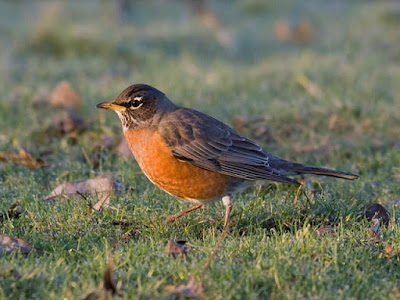 |
| American Robin. Greg Gillson. |
Range in Kansas: American Robins are year-round residents throughout Kansas.
Identification: This is a key species for comparing with an unknown bird.
Size: 10 inches long from bill tip to tail tip. About the same size as a Blue Jay or one of the Scrub-Jays. Larger than Red-winged Blackbird. Smaller than a Mourning Dove.
Shape: Very plump with a fairly long tail.
Bill: Straight and fairly slender, curved at the tip.
Color: Gray-brown upperparts, rusty orange breast.
Habitat, range & behavior: Open woodlands, farmlands, urban parks and lawns.
Migratory, breeds north across Alaska and Canada. Resident in most of the United States (lower 48). Winters in the United States, Mexico, to central America.
Hops on your lawn turning head this way and that looking for food. Their caroling song is one of the early signs of spring in the north.
Food and feeder preference: American Robins eat earthworms and other invertebrates in the lawn. May eat fruit from a tray feeder or the ground. Eat small berries from trees and bushes.
3. Mourning Dove (Zenaida macroura)
Mourning Doves are the most widespread and most frequent backyard bird in the Lower 48 states of the United States.
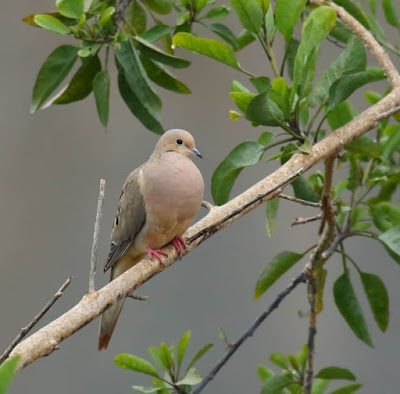 |
| Mourning Dove. Greg Gillson. |
Range in Kansas: Mourning Doves are year-round residents throughout Kansas.
Identification: This is a key species for comparing with an unknown bird.
Size: About 12 inches long from bill tip to tail tip. About same size as Northern Flicker. Larger than American Robin. Slightly smaller than domestic city pigeon.
Shape: Very plump with a small round head. Tail is long and pointed. Legs are short.
Bill: Small and rather slender.
Color: Pale brown-pink body, darker wings and tail. White edges on side of tail.
Habitat, range & behavior: Semi-open areas such as urban areas, farmlands, woods. Often seen perched on wires, fences.
It is a resident across the lower-48 states and Mexico, with some movement out of northern areas in winter.
Their mournful cooing is a familiar spring birdsong.
Food and feeder preference: Mourning Doves eat seeds almost exclusively. Attract with black oil sunflower seeds on a large sturdy tray feeder or on the ground.
4. Blue Jay (Cyanocitta cristata)
A common and well-known bird in the eastern half of the United States.
 |
| Blue Jay. skeeze from Pixabay |
Range in Kansas: Blue Jays are year-round residents throughout Kansas.
Identification:
Size: About that of American Robin.
Shape: Fluffy, large crested head, ample tail. Large strong legs.
Bill: Black, long and stout.
Color: Blue above, white below. Black neck collar. White patches in wing.
Habitat, range & behavior: Woodlands and towns in the eastern half of the United States. In summer into southern Canada.
Bold and brash. May bully smaller birds. Jays gulp lots of seeds or other food at once, storing it in their crop. Then they fly off and bury food items in a hidden cache.
Food and feeder preference: Omnivorous. They can quickly empty your feeder! Because they are also aggressive toward other feeder birds, some people put mesh cages around smaller bird feeders. Small birds can go through, squirrels and larger “pest” birds are prevented entry. Some people feed jays peanuts, perhaps away from the seed feeders.
5. American Crow (Corvus brachyrhynchos)
This larger all-black bird is common in cities and country. Its cawing call is familiar to most people.
 |
| American Crow. Greg Gillson |
Range in Kansas: American Crows are year-round residents throughout Kansas.
Identification: This is a key species for comparing with an unknown bird.
Size: About 17-1/2 inches long from bill tip to tail tip, though there is much size variation throughout its range. Larger than blackbirds and grackles. Smaller than ravens.
Shape: Thick neck, large head, rather short square-ended tail. Longer legs. In flight has rounded wing tips with each primary feather separated from others forming “fingers.”
Bill: As long as head, thick, black.
Color: Glossy black throughout.
Habitat, range & behavior: They prefer open areas with trees, fields, farms, cities.
They are common across most of the United States lower-48, except in the desert southwest. They move into southern Canada in summer.
They gather in evening communal roosts in large flocks that may number into the thousands and then move out at dawn into the surrounding area.
Food and feeder preference: Omnivorous, they feed on large insects, grain, small mammals, carrion. You probably don’t want these large entirely-black birds in your backyard feeders. So don’t feed table scraps to birds.
6. Red-bellied Woodpecker (Melanerpes carolinus)
This is one of the most common backyard species in the eastern half of the United States.
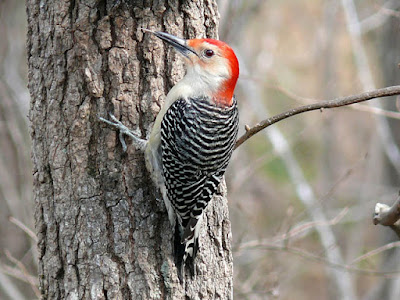 |
| Red-bellied Woodpecker. skeeze from Pixabay |
Range in Kansas: Red-bellied Woodpeckers are year-round residents in central and eastern Kansas, absent in western Kansas.
Identification:
Size: Fairly large for a backyard bird. Between a Starling and American Robin in size. Smaller than a Northern Flicker.
Shape: Stout with large head and short tail. Clings to tree trunk on strong short legs propped up with short stiff tail.
Bill: Long, chisel-shaped.
Color: Pale gray body, many thin black-and-white bars across back and wings. Red nape, extending forward on crown on male.
Habitat, range & behavior: These birds are found in many woodland types, including oak, hickory and pine.
They are found from the eastern slope of the Rocky Mountains in the lower-48 states from Texas to extreme southern Canada, and eastward from Florida northward just to the southern edge of the New England states.
In typical woodpecker fashion, it hitches up the tree trunk and larger branches.
Food and feeder preference: This species eats insects and nuts. They may eat peanuts from a tray feeder and eat from a suet block.
7. Black-capped Chickadee (Poecile atricapillus)
This is a common backyard bird in the northern half of the United States.
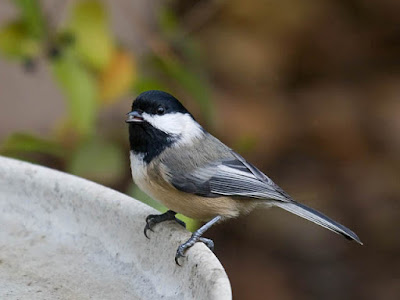 |
| Black-capped Chickadee. Greg Gillson |
Range in Kansas: Black-capped Chickadees are year-round residents in most of Kansas, absent in extreme southern Kansas.
Identification:
Size: Chickadees are small birds, the same general size as an American Goldfinch.
Shape: Round body, big round head, long tail with rounded tip.
Bill: Short, straight, stout.
Color: Gray above, buffy below. Black cap and bib with white lower face. White edges on wing feathers.
Habitat, range & behavior: Deciduous and mixed forests.
They range from the northern half of the United States, southern half of Canada, and most of Alaska.
Small flocks flit actively from tree to tree acrobatically gleaning insects from twig tips. In winter chickadees make up the core of mixed-species flocks also containing nuthatches, kinglets, creepers, woodpeckers and others.
Food and feeder preference: Seeds, insects, berries. They eat at tube, hopper and tray feeders. They love black oil sunflower seeds and suet.
You may like my in-depth article on attracting Black-capped Chickadees.
8. European Starling (Sturnus vulgaris)
Introduced to North America in the late 1800’s, they crossed the continent, often to the detriment of native cavity-nesting birds. The prime example of an invasive species.
 |
| European Starling. Greg Gillson. |
Range in Kansas: European Starlings are year-round residents throughout Kansas.
Identification:
Size: About the size of a Red-winged Blackbird. Smaller than an American Robin. Larger than a White-crowned Sparrow or Spotted/Eastern towhee.
Shape: Stocky with large head, short square-ended tail. Longer legs.
Bill: As long as head. Sharp pointed. Yellow in spring, otherwise dark.
Color: They are grayish brown much of the year, with glossy iridescence and white spotting during the spring.
Habitat, range & behavior: Lowland birds that need trees large enough for nest cavities but plenty of open area for feeding. They are most abundant in urban and suburban areas where they find food and artificial nest cavities.
Resident from coast-to-coast from southern Canada to northern Mexico. In summer north across Canada and Alaska. Native range is Europe to Pakistan, north Africa.
Often viewed as a pest, starlings often bully other backyard birds, taking over bird feeders, and stealing nest cavities from smaller native birds.
In winter they can form into flocks of ten’s of thousands.
Food and feeder preference: European Starlings eat primarily insects when available, often feeding on the ground. Discourage them from your backyard hopper and tray feeders by never feeding birds table scraps (including bread or meat). They have weak feet and do not perch well on tube feeders. A cage mesh around smaller hopper feeders may keep them out.
9. American Goldfinch (Spinus tristis)
A beautiful tiny finch familiar to many in it’s bright yellow summer plumage. Colloquially called a “wild canary.”
 |
| American Goldfinch. Greg Gillson |
Range in Kansas: American Goldfinches are year-round residents throughout Kansas.
Identification: This is a key species for comparing with an unknown bird.
Size: Very small at about 5 inches from bill tip to tail tip. Similar in size to a chickadee. Larger than hummingbirds. Smaller than juncos and House Finches.
Shape: Tiny, somewhat plump with larger head and short tail.
Bill: Short, conical, pink.
Color: Males in summer are bright lemon yellow with black forehead and black wings and tail with white bars. White under tail coverts. Females dull olive, wings and tail browner. Winter birds are pale grayish-yellow with tan and brown wings and tail.
Habitat, range & behavior: This species is found in weedy fields and similar clearings with thistles and similar plants.
It is found coast-to-coast throughout the year across most of the middle lower-48 states. In summer moves north to the Canada border. In the winter found south to the Mexico border.
The flight is highly undulating, rising and falling as they flap in short bursts.
Besides a long, sweet lilting song, they call in flight a lilting 4-part: “potato chip!”
Food and feeder preference: Feeds on weed seeds, thistle seed. May eat black oil sunflower seeds from tube feeder. Love Nyjer seed in a feeder called a “thistle sock.”
You may like my in-depth article on attracting American Goldfinches.
10. Red-winged Blackbird (Agelaius phoeniceus)
These noisy flocking birds are most often found in marshes. But in winter they are found in backyards.
 |
| Male Red-winged Blackbird. Greg Gillson. |
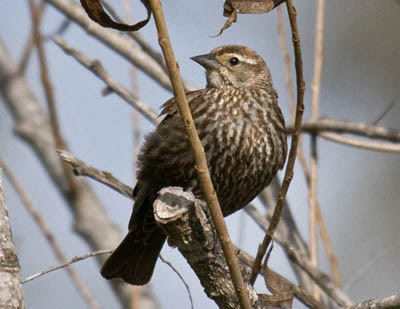 |
| Female Red-winged Blackbird. Greg Gillson. |
Range in Kansas: Red-winged Blackbirds are year-round residents throughout Kansas.
Identification: This is a key species for comparing with an unknown bird.
Size: About 8-3/4 inches long from bill tip to tail tip. About the size of a Northern Cardinal. Smaller than an American Robin.
Shape: Pot-bellied with a longer bill and flat forehead. Tail average.
Bill: Long and sharp pointed.
Color: Males are black with red and yellow shoulder patch. Females are streaked brown and rusty (sparrow-like but pointed bill and flat forehead).
Habitat, range, and behavior: Cattail marshes and wetlands are their summer habitat. In winter they feed in grain fields.
They breed across most of the North American continent. In winter they withdraw from most of Alaska and Canada.
They are found in colonies in summer and large flocks in winter.
Food and feeder preference: They eat insects in summer. In winter they eat grain and seeds. They visit feeders, more often in large winter flocks, and eat most seeds and suet.
11. Downy Woodpecker (Dryobates pubescens)
This tiny woodpecker is found across the United States.
 |
| Downy Woodpecker. Greg Gillson |
Range in Kansas: Downy Woodpeckers are year-round residents throughout Kansas.
Identification:
Size: Bigger than a junco or House Finch. Smaller than a Red-winged Blackbird. About the same size as a White-crowned Sparrow, but with a much shorter tail.
Shape: Stocky with large head and short stiff tail.
Bill: Short, chisel shaped.
Color: Black-and-white striped head. Black wings with white spots. Solid white back. White under parts. Black tail with white outer tail feathers with black bars or spots. Male with small red spot at back of head.
Habitat, range & behavior: Found in small deciduous trees, willows, and even weed stocks such as teasel, especially near water.
Ranges coast-to-coast across all but northernmost parts of Canada and Alaska south to the southern US. Absent in the desert southwest.
Interestingly, I learned today that the males may more often be found in smaller plants and twigs, while females are more likely on tree trunks.
Food and feeder preference: Insects, fruits, and seeds. Gleans arthropods from the bark of trees. Attract with suet feeder. Will also eat black oil sunflower seeds.
12. Dark-eyed Junco (Junco hyemalis)
Colloquially called “snowbirds,” they often arrive in backyards in winter from nearby mountain forests or more northern climes.
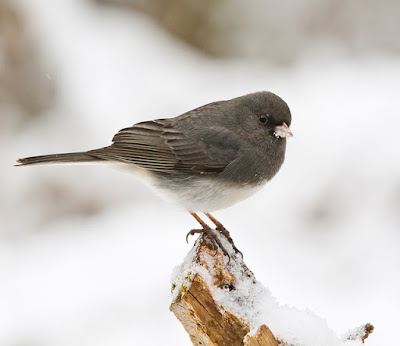 |
| Dark-eyed Junco. skeeze from Pixabay |
Range in Kansas: Dark-eyed Juncos are winter visitors throughout Kansas.
Identification:
Size: Small birds about the size of a House Finch.
Shape: Round body, short neck, round head, fairly long square-ended tail.
Bill: Short, pointed, conical, pink.
Color: Eastern birds are a darker all-gray with white belly. Western birds have jet black hood over head, brown back, and pink sides.
Habitat, range & behavior: Breed in coniferous forests. Winters widely. Avoids heavy brush, preferring widely spaced bushes.
Breeds across most of Canada, Alaska, and the western half of the United States. Winters from southern Canada and all of the lower 48-states to extreme northern Mexico.
Spend much of their time hopping and feeding on the ground.
Food and feeder preference: Eats mostly seeds, also insects in summer. Readily feed at backyard feeders on mixed seeds on hopper or tray feeders and ground.
You may like my in-depth article on attracting Dark-eyed Juncos.
13. House Sparrow (Passer domesticus)
Like the starling, this is another bird introduced from Europe in the 1800’s. This sparrow is commonly found in cities and farmlands. It is considered a pest in most areas where it has been introduced.
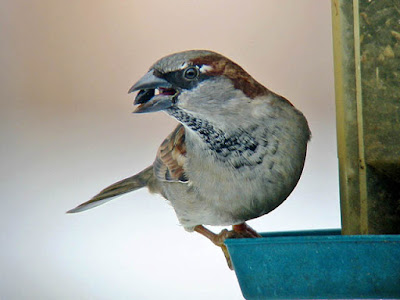 |
| House Sparrow. Greg Gillson |
Range in Kansas: House Sparrows are year-round residents throughout Kansas.
Identification:
Size: The size of a House Finch or Dark-eyed Junco.
Shape: Chunkier than native North American sparrows with large head, barrel chest, short neck, medium tail, short legs.
Bill: Short, conical.
Color: Males are brown and gray with a black mask. Females lack the black and are tan and brown with a pale line back from the eye.
Habitat, range & behavior: Cities and farms.
Range in North American from southern Canada through Central America. In summer northward through Canada to southern Alaska. Originated in Middle East and spread to most of Europe and Asia. Introduced in South America, Africa, Australia–nearly anywhere there are people and cities.
They tend to be messy… and have a good appetite, and may occur in large noisy chirping flocks. They are aggressive toward other feeder birds.
Food and feeder preference: They eat grain, seed, and insects. To discourage them from your hopper and tray feeders do not feed birds human food scraps. They have a bit of difficulty eating from tube feeders.
14. Tufted Titmouse (Baeolophus bicolor)
Related to chickadees, they lack the black bib, but have a crest instead.
 |
| Tufted Titmouse. anne773 from Pixabay |
Range in Kansas: Tufted Titmice are year-round residents in eastern Kansas, absent in western Kansas.
Identification:
Size: A small bird, but a large titmouse, this species is larger than chickadees, about the size of a junco or House Finch.
Shape: Rounded body, long full tail, big head, long legs.
Bill: Short and stout, compressed (taller than wide), black.
Color: Dark blue-gray above, pale below. Black feathers around eye accentuates its size.
Habitat, range & behavior: Lives in deciduous forests with heavy canopy, parks.
Found in eastern and southeastern United States is expanding its range north and west.
Food and feeder preference: Insects and seeds. At your hopper or tray feeder they like black oil sunflower seeds and suet.
15. Carolina Wren (Thryothorus ludovicianus)
This is a fairly common backyard bird in the much of the eastern United States.
 |
| Carolina Wren. theSOARnet from Pixabay |
Range in Kansas: Carolina Wrens are year-round residents in eastern and southeastern Kansas, absent in northern, central and western Kansas.
Identification:
Size: A smaller bird, between the size of American Goldfinch and House Finch.
Shape: Round body, short neck, flat head, long tail flipped about actively.
Bill: Fairly long, thin, pointed and slightly curved.
Color: Upper parts rusty brown with black bars on the wings and tail. A white eyebrow line and buff under parts.
Habitat, range & behavior: Shrubby thickets and brushy suburban yards.
It is found in the southeastern United States and Yucatan. Northern parts of range expand and contract depending upon harshness of winters.
Males sing throughout the year and are very loud for their size.
Food and feeder preference: Feed mostly on insects and spiders. They will feed on suet.
16. Northern Flicker (Colaptes auratus)
Of all the bird identification questions I get asked, this common larger backyard bird is the bird most people ask about. It doesn’t occur to those unfamiliar with it that this could be a woodpecker.
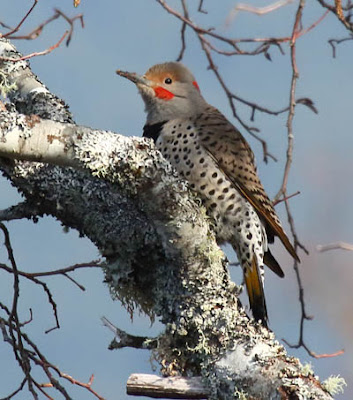 |
| Northern Flicker. Greg Gillson. |
Range in Kansas: Northern Flickers are year-round residents throughout Kansas.
Identification:
Size: About the size of a Mourning Dove. Larger than a robin.
Shape: Stocky with short legs, short tail, big head.
Bill: As long as head, thin, slightly curved.
Color: Back is brown with black bars. Under parts pinkish with black spots. Undersides of black wing and tail feathers are bright salmon red (West) or yellow (East). Head gray (West) or brown (East) and males with red (West) or black (East) whisker marks and nape marks (East). Black crescent across chest. White rump seen in flight.
Habitat, range & behavior: Found in woodland edges and forests.
Year-round resident from extreme southern Canada, across all of the lower-48 states and in the mountains of Mexico and Middle America. In summer breeds northward well into Canada and Alaska.
Frequently noted hopping on ground pecking in the ground for insects. In late spring, males proclaim their territory by rapid pounding on a hollow tree branch, though the ringing of metal downspouts at dawn is louder and carries much farther, to the exasperation of anyone trying to sleep inside!
Food and feeder preference: Ants and beetles are their primary foods. Will eat black oil sunflower seeds and are attracted to suet.
17. House Finch (Haemorhous mexicanus)
These are one of the most common backyard birds in the United States. There are other red finches, but these are the ones most likely in residential areas.
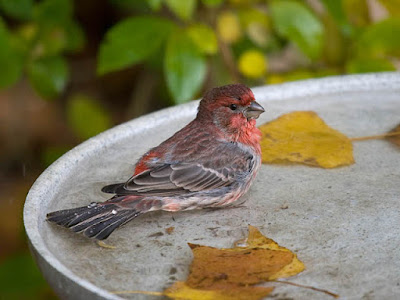 |
| House Finch. Greg Gillson. |
Range in Kansas: House Finches are year-round residents in south-central and east-central Kansas, absent or local elsewhere.
Identification: This is a key species for comparing with an unknown bird.
Size: About 6 inches from bill tip to tail tip. Larger than goldfinches and chickadees. Smaller than a White-crowned Sparrows or Spotted/Eastern towhees.
Shape: Medium build with a medium-long notched tail. Round head.
Bill: Short, conical.
Color: Brown and gray above with streaks on the sides of the pale underparts. Males with red (sometimes orange or rarely yellow) crown, chest, rump.
Habitat, range & behavior: You’ll find small flocks on wires, in short tree tops and in bushes. Originally deserts and grasslands. Rural areas and towns are where they’re now most common.
Formerly found in the western United States and Mexico. Then introduced into the northeastern United States, but now found in nearly all of the lower-48 states and extreme southern Canada. Rare in plains states (Dakotas to Texas) and southern Florida.
House Finches are not territorial, but males sing throughout the year–a lively, wiry song ending in a couple of buzzy notes.
Food and feeder preference: House Finches love sunflower seeds and tube feeders. May eat from thistle socks.
You may like my in-depth article on attracting House Finches.
18. Eastern Bluebird (Sialia sialis)
A beloved bird of open fields with trees and fence lines for perching.
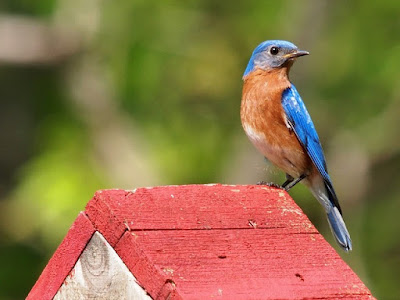 |
| Eastern Bluebird. skeeze from Pixabay |
Range in Kansas: Eastern Bluebirds are summer residents in eastern, central, and southern Kansas.
Identification:
Size: Larger than House Finches. Much smaller than starlings. About length of White-crowned Sparrow but differently proportioned–bigger body, shorter tail.
Shape: Chunky, large head, short tail. Bill: Straight, fairly slender, curved at tip.
Color: Males are brilliant blue above (including wings and tail), rusty orange below with white belly and under tail. Females are often much paler, almost grayish.
Habitat, range & behavior: Found in pasture, fields, golf courses, open woodland edges.
They are resident in most of eastern US, highlands of Middle America. In summer reach northernmost eastern US and southernmost eastern Canada, withdrawing somewhat in winter.
They readily use nest boxes, but the entrance hole must be smaller than the head of a starling, and without a perch.
Food and feeder preference: They eat flying insects primarily, but also other invertebrates and berries. They will eat mealworms at your feeder and frequent birdbaths.
19. Common Grackle (Quiscalus quiscula)
Sometimes considered a pest to crops, grackles are longer and lankier than very similar blackbirds.
 |
| Common Grackle. GeorgiaLens from Pixabay |
Range in Kansas: Common Grackles are year-round residents in central and eastern Kansas, summer residents only in western Kansas.
Identification:
Size: Larger than Red-winged Blackbirds, they are near the length of Mourning Doves.
Shape: Long, with long full keel-shaped tail, long legs, flat crown.
Bill: Longer than head, pointed, but stouter than other blackbirds.
Color: Glossy black with hint of bronze or green on head (depending upon population). Yellow eye.
Habitat, range & behavior: They are found in agricultural areas, woodland edges, city parks and lawns.
Resident in the southeastern United States. In summer they migrate northward and west to the central United States and Canada.
They monopolize feeders and are bullies toward other birds.
Food and feeder preference: Grain, corn, acorns, small aquatic fish and amphibians. To discourage them, use tube feeders, rather than hopper or tray feeders. Don’t over-feed, keep spilled seed picked up.
20. American Tree Sparrow (Spizelloides arborea)
These birds nest at the edge of the tundra. Don’t expect the first ones in fall until late October, at least.
 |
| American Tree Sparrow. Greg Gillson. |
Range in Kansas: American Tree Sparrows are winter visitors throughout Kansas.
Identification:
Size: These are smaller sparrows, the size of juncos.
Shape: Small roundish body, rounded head, long tail.
Bill: Small conical. Bicolored–dark upper and yellow under mandibles.
Color: Pale gray breast and face. Rusty back, wings, crown, line back from eye. Two white wing bars. Dark central breast spot.
Habitat, range & behavior: In winter they like open weedy fields with small trees.
Breed in Alaska and northern Canada. Winter in northern half of the United States.
These birds spend much more time on the ground than in trees.
Food and feeder preference: They visit feeders for small seeds, but spend more time on the ground under the feeders.
21. Barn Swallow (Hirundo rustica)
These swallows are widely distributed throughout the world, primarily breeding in the northern hemisphere, and wintering in the mid-latitudes and southern hemisphere.
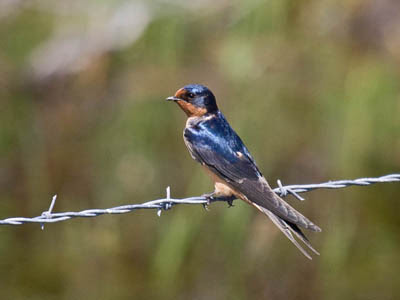 |
| Barn Swallow. Greg Gillson. |
Range in Kansas: Barn Swallows are summer residents throughout Kansas.
Identification:
Size: About the size of a House Finch but with a much longer tail.
Shape: Stocky, short necked but with long body and tail. Tail is forked, with very long outer tail feathers. Wings pointed.
Bill: Short, wide.
Color: Glossy dark purplish-blue above. Pinkish-orange below.
Habitat, range & behavior: Barn Swallows live in open country, frequently near humans. Farmlands. Nest in barns, under small bridges.
In North America breed from Mexico to northern Canada and Alaska, wintering from southern Mexico throughout most of South America.
Frequently seen swooping low over the ground hunting flying insects. Perch on wires, fences. Voice is twitters and chirps with grating sounds.
Food and feeder preference: Eat flying insects on the wing and are not attracted to backyard feeders.
22. Brown-headed Cowbird (Molothrus ater)
Cowbirds are small blackbirds lay their eggs in the nests of other smaller birds, such as warblers. The adoptive parents raise their young!
 |
| Brown-headed Cowbird. Greg Gillson. |
Range in Kansas: Brown-headed Cowbirds are year-round residents in central and southeastern Kansas, summer residents in northern and western Kansas.
Identification:
Size: Larger than White-crowned Sparrows, but smaller than Rose-breasted or Black-headed Grosbeaks. Smaller than other blackbirds, starlings, and grackles.
Shape: Perhaps a little bit pot-bellied. Medium length tail. Flat forehead as typical for blackbirds.
Bill: Rather thick and stout.
Color: Males are glossy black with rich brown head. Females are dusty gray-brown throughout. Long-held juvenile plumage similar to pale female, scaly, being fed by Yellow Warbler or Song Sparrow or a hundred other host species.
Habitat, range & behavior: They are found in woodlands and farms. Also with other blackbirds in winter at shopping center parking lots.
In summer they breed across Canada and most of the United States and Mexico. In winter they move south out of Canada and occupy both coasts and southeastern States in the US.
These small blackbirds join other flocks of blackbirds in cattle feedlots. You may see cowbirds riding on the backs of cattle, sheep, or horses. They originally rode on the backs of American bison on the Great Plains, but expanded when forests were cut.
Food and feeder preference: Cowbirds eat grains, seeds, and insects. They will readily come to hopper and platform feeders. They are larger and more aggressive, so keep other birds from feeders and have a big appetite!
23. Indigo Bunting (Passerina cyanea)
Don’t mistake Indigo Buntings for the larger Blue Grosbeak. As the name suggests, the grosbeak has a much larger and thicker bill, along with rusty wing bars, lacking in Indigo Buntings.
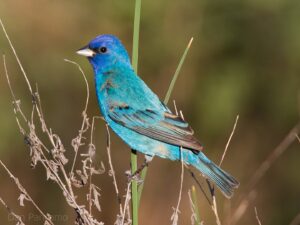
Range in Kansas: Indigo Buntings are summer residents throughout Kansas.
Identification:
Size: These birds are a bit smaller than a House Sparrow.
Shape: Plump. Large round head. Medium short tail.
Bill: Large and conical.
Color: Males are deep blue. Females are pale gray-brown with diffuse streaks below.
Habitat, range & behavior: Open woodlands and clearings. Country farm roads.
They are found in the East and parts of the Southwest, north to southern Canada.
Sing from the tallest tip of tree or telephone lines, a cheerful paired bouncy song very similar to American Goldfinch. In fact, they are sometimes called “blue goldfinches” because of this!
Food and feeder preference: These birds will eat seeds from hopper feeders, perhaps more so in the late spring when they first arrive during migration.
24. Eastern Kingbird (Tyrannus tyrannus)
These birds often build nests in trees that overhang streams.
 |
| Eastern Kingbird. Greg Gillson. |
Range in Kansas: Eastern Kingbirds are summer residents throughout Kansas.
Size: About the size of a Red-winged Blackbird. Smaller than a robin.
Shape: Fairly sleek. Perches upright with big puffy head, full tail.
Bill: Fairly long, wide at base,
Color: Black head. Black tail with white band at tip. Dark gray upper parts. White under parts.
Habitat, range & behavior: Farms, clearings in woodlands.
Found across Canada and in the United States east from the Rocky Mountains.
These birds perch on fence lines, tips of small trees. Sally out and snatch flying insects and return to perch.
Food and feeder preference: They eat insects and do not come to feeders.
25. Baltimore Oriole (Icterus galbula)
These are beautiful summer songbirds in the East.
 |
| Baltimore Oriole. Michael McGough from Pixabay. |
Range in Kansas: Baltimore Orioles are summer residents throughout most of Kansas, spring and fall migrants only in southwestern Kansas.
Identification:
Size: Smaller than a robin; just a bit smaller than a Red-winged Blackbird.
Shape: Rounded belly. The body is long with long under tail coverts, but the tail is somewhat short. Large head.
Bill: Fairly long and heavy. Pointed, slightly curved.
Color: The males are brilliant orange below, black above, including a hood over the head. Wings are black with two wing bars. Females are yellowish orange below and more olive-green above, but still show the white wing bars.
Habitat, range & behavior: Shade trees and deciduous woodlands.
Found east of the Rocky Mountains from Canada southward. Winter in far southeastern coastal US and Florida, and southward.
Orioles build sock-like hanging nests made of long fibers. These nests often last the winter and may be observed once the leaves are off the trees.
Food and feeder preference: These birds eat insects, fruit, and nectar. You may be able to attract orioles to your feeders with cut oranges and special oriole nectar feeders similar to hummingbird feeders.
26. Western Kingbird (Tyrannus verticalis)
You may note these birds aggressively and noisily chasing off other birds, such as crows and hawks, from their territories. And other interloping Western Kingbirds, of course.
 |
| Western Kingbird. Greg Gillson. |
Range in Kansas: Western Kingbirds are summer residents in central and western Kansas, absent in eastern Kansas.
Identification:
Size: Larger than phoebes. Smaller than American Robins. The same size as Red-winged Blackbirds.
Shape: Long body with heavy chest. Large head with raised hind crown. Large bill. Long full tail. Upright posture.
Bill: Fairly long, but shorter than head, stout and wide at the base.
Color: Gray head, back, and chest. Yellow belly. Brown wings. Black tail with contrasting white outer tail feathers.
Habitat, range & behavior: Open country.
Summers in the western half of the United States and adjacent southern Canada.
Perches on electric wires, fence lines. Chases flying insects and returns to perch.
Food and feeder preference: Feeds on flying insects. Does not come to feeders.
27. Brown Thrasher (Toxostoma rufum)
These birds are accomplished singers, with over 1100 different songs recorded!
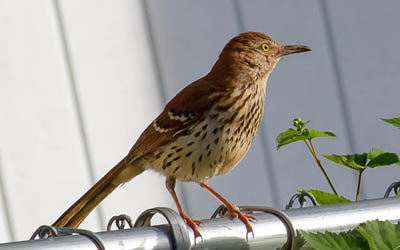 |
| Brown Thrasher. Linda Jones. CC0. |
Range in Kansas: Brown Thrashers are summer residents throughout Kansas.
Identification:
Size: Longer than a robin, smaller than a flicker.
Shape: Pot-bellied. Long tail with rounded tip. Large head.
Bill: Long and thin, slightly curved down.
Color: Rusty above. Gray face. Heavy rusty streaks below on cream-colored under parts. Two white wing bars.
Habitat, range & behavior: These birds live in woodland edges and hedges.
They are year-round residents in the Southeast. In summer they also breed northward, east of the Rocky Mountains to southern Canada.
You may find them feeding on the edge of lawns with a very horizontal posture. They may mimic other bird songs and calls.
Food and feeder preference: They primarily eat insects and invertebrates. But they will also come to platform feeders for sunflower seeds, nuts, suet, berries.
Common Birds in Kansas
To determine how common each species is I used the data from actual bird sightings from the citizen science program eBird. Birds are listed by frequency. That is, how often the species is recorded on checklists submitted to eBird (a percentage).
When choosing the birds to include in this article I leaned strongly to birds that are present throughout the year in good numbers. Thus, many of the common birds are year-round residents. This means that they live in the same location all year. They raise their young in your neighborhood. They don’t migrate. Or if the species does migrate, the ones living in your area don’t. If this is the case, some migrants may move into your area during certain times of year, adding to the same species that are in your yard full time.
Some migrant birds visit your yard during the “summer.” Often, they arrive in spring and remain until late fall. They nest and raise their young in your neighborhood. These are the summer residents.
Other migrant birds visit your backyard during the “winter.” Some of these winter visitors may arrive in July and remain into April. Others may only be found in the cold of December or January. They key here is that they nest and raise their young somewhere else. They only visit your yard in the non-breeding season.
Migration is an amazing spectacle.
There will be birds that fly through your region in spring or fall (or both). They may visit your backyard only a few days or weeks a year. They aren’t regular enough, or stay long enough, to be included in this article. But the number of briefly visiting migrant birds could double the number of species presented here. You may see them over time. Consult checklists in eBird for your county to see what is possible.
I have generally excluded common waterfowl, birds of prey, shorebirds, seabirds, and others that aren’t usually found in residential areas. But they may certainly fly over or be seen regularly if your home is on a shoreline, for instance.
Most common backyard birds in Kansas throughout the year
The following list is the backyard birds that are, on average, most common throughout the entire year. The list is ordered by most common based on the frequency of how often each species is recorded on checklists submitted to eBird.
- Northern Cardinal (48% frequency)
- American Robin (40%)
- Mourning Dove (40%)
- Blue Jay (39%)
- American Crow (33%)
- Red-bellied Woodpecker (32%)
- Black-capped Chickadee (32%)
- European Starling (31%)
- American Goldfinch (28%)
- Red-winged Blackbird (28%)
- Downy Woodpecker (28%)
- Dark-eyed Junco (26%)
- House Sparrow (25%)
- Tufted Titmouse (23%)
- Carolina Wren (22%)
- Northern Flicker (22%)
- House Finch (22%)
- Eastern Bluebird (22%)
- Common Grackle (18%)
Most common backyard birds in Kansas in winter
- Dark-eyed Junco (53% frequency)
- Northern Cardinal (47%)
- American Crow (38%)
- Black-capped Chickadee (36%)
- Red-bellied Woodpecker (34%)
- Downy Woodpecker (34%)
- Blue Jay (34%)
- European Starling (33%)
- American Robin (32%)
- American Goldfinch (28%)
- Northern Flicker (28%)
- House Sparrow (27%)
- House Finch (24%)
- Tufted Titmouse (24%)
- Mourning Dove (23%)
- Eastern Bluebird (21%)
- American Tree Sparrow (20%)
Most common backyard birds in Kansas in summer
- Mourning Dove (60% frequency)
- Northern Cardinal (47%)
- American Robin (42%)
- Common Grackle (34%)
- Blue Jay (34%)
- Barn Swallow (34%)
- Brown-headed Cowbird (31%)
- House Sparrow (30%)
- European Starling (29%)
- Indigo Bunting (28%)
- Eastern Kingbird (28%)
- American Goldfinch (26%)
- Baltimore Oriole (25%)
- American Crow (25%)
- Eastern Bluebird (24%)
- Red-bellied Woodpecker (23%)
- Black-capped Chickadee (22%)
- Western Kingbird (22%)
- Carolina Wren (21%)
- Brown Thrasher (21%)
How do birds differ between winter and summer?
Dark-eyed Juncos, American Crows, Black-capped Chickadees, Red-bellied Woodpeckers, Downy Woodpeckers, American Tree Sparrows are more common in winter.
Mourning Doves, American Robins, Common Grackles, Barn Swallows, Brown-headed Cowbirds, Indigo Buntings, Eastern Kingbirds, Baltimore Orioles, Western Kingbirds are more common in summer.
Common Backyard Birds of Wichita, Kansas
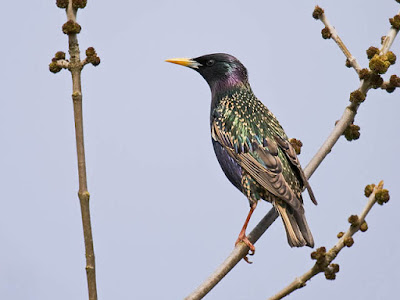 |
| European Starling. Greg Gillson |
- Northern Cardinal (44% frequency)
- American Robin (43%)
- European Starling (36%)
- Blue Jay (34%)
- Mourning Dove (30%)
- Black-capped Chickadee (28%)
- Downy Woodpecker (26%)
- House Sparrow (25%)
- American Crow (24%)
- American Goldfinch (24%)
- Carolina Wren (21%)
- Red-bellied Woodpecker (21%)
- House Finch (21%)
- Dark-eyed Junco (20%)
Mourning Doves, American Crows, and Red-bellied Woodpeckers are less common in Wichita than in the rest of the state on average.
Otherwise, the most common backyard birds are expected in about the same frequencies in Wichita as in all of Kansas, on average.
Common Backyard Birds of Kansas City, Kansas
- Northern Cardinal (68% frequency)
- Blue Jay (56%)
- Black-capped Chickadee (54%)
- American Crow (50%)
- Red-bellied Woodpecker (49%)
- Downy Woodpecker (46%)
- Tufted Titmouse (45%)
- American Robin (44%)
- European Starling (42%)
- Dark-eyed Junco (42%)
- Mourning Dove (41%)
- American Goldfinch (39%)
- House Sparrow (39%)
- White-breasted Nuthatch (38%) Learn about this species on eBird
- Eastern Bluebird (31%)
- Carolina Wren (28%)
- House Finch (27%)
- Northern Flicker (27%)
- White-throated Sparrow (24%)
- Red-headed Woodpecker (23%) Learn about this species on eBird
- Red-winged Blackbird (22%)
- Yellow-rumped Warbler (22%)
Northern Cardinals, Blue Jays, Black-capped Chickadees, American Crows, Red-bellied Woodpeckers, Downy Woodpeckers, Tufted Titmice, European Starlings, Dark-eyed Juncos, House Sparrows, White-breasted Nuthatches, Eastern Bluebirds are more common in Kansas City, Kansas, than in the state as a whole, on average.
Common Backyard Birds of Topeka, Kansas
- Northern Cardinal (59% frequency)
- Blue Jay (51%)
- American Robin (50%)
- Black-capped Chickadee (48%)
- Mourning Dove (48%)
- Red-bellied Woodpecker (42%)
- Downy Woodpecker (39%)
- American Crow (38%)
- House Finch (34%)
- Tufted Titmouse (32%)
- European Starling (31%)
- Dark-eyed Junco (31%)
- House Sparrow (30%)
- Carolina Wren (30%)
- American Goldfinch (30%)
- Northern Flicker (28%)
- Eastern Bluebird (25%)
- Common Grackle (24%)
- Red-winged Blackbird (23%)
- White-breasted Nuthatch (21%) Learn about this species on eBird
Northern Cardinals, Blue Jays, American Robins, Black-capped Chickadees, Red-bellied Woodpeckers, Downy Woodpeckers, House Finches are more common in Topeka than the average for the state of Kansas.
Wrapping Up
If you are tempted to explore Kansas beyond your backyard, there are other beautiful birds to be found. Here are some of them:
Grassland and Farmland Birds:
- Western Meadowlark: The state bird of Kansas, these yellow-breasted birds with a black V-mark on their chest fill the air with their sweet, whistled songs in open fields.
- Dickcissel: This striking orange and black bunting nests in grasslands, offering its rhythmic “dick-cissel-cissel” song during the breeding season.
- Eastern Bluebird: These bright blue birds with a reddish chest prefer open areas with scattered trees, where they perch and hunt for insects.
- American Goldfinch: These yellow finches with black wings are common visitors to feeders, adding a splash of color to winter landscapes.
- Red-winged Blackbird: These glossy black birds with red shoulder patches are abundant in marshes and fields, known for their loud “konk-la-ree” calls.
Forest and Woodland Birds:
- Carolina Wren: These small brown wrens with a long, barred tail inhabit woodlands and gardens, filling the air with their loud, complex songs.
- Blue Jay: These striking blue birds with a white crest and black bars are common in forests and backyards, known for their raucous calls and playful antics.
- Black-capped Chickadee: These small, gray birds with a black cap and bib flit through trees, searching for insects and offering their cheery “chick-a-dee-dee” calls.
- Brown-headed Cowbird: These brown birds with a dark head often lay their eggs in the nests of other songbirds, creating a brood parasitism phenomenon.
- Wild Turkey: While not technically a songbird, these large, majestic birds are increasingly common in wooded areas and fields, adding a touch of grandeur to the Kansas landscape.
Frequently Asked Questions
What is the state bird of Kansas?
The proud state bird of Kansas is the Western Meadowlark (Sturnella neglecta)! These charismatic yellow-breasted birds with a black V-mark on their chest grace open fields and grasslands throughout the state, filling the air with their sweet, whistled songs. They were chosen as the state bird in 1925 after a statewide vote involving over 121,000 schoolchildren, beating out the Bobwhite and Northern Cardinal.
The Western Meadowlark embodies the spirit of Kansas with its cheerful song, open grassland habitat, and resilience. Seeing these beautiful birds soaring and singing in the open plains is a quintessential Kansas experience, making them a fitting symbol for the state.
So, the next time you hear that melodic whistled song while exploring the Kansas countryside, take a moment to appreciate the state bird and its captivating presence in the heart of the Sunflower State!
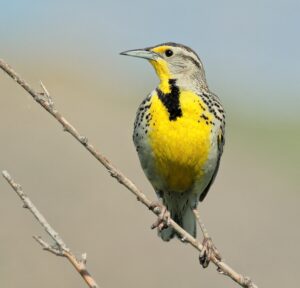
What birds are invasive in Kansas?
Invasive species, including some birds, pose a significant threat to native ecosystems and biodiversity in Kansas. Here are some common invasive birds you might encounter in the state:
House Sparrow (Passer domesticus): These aggressive, brown-streaked birds compete with native songbirds for food and nesting sites, disrupting natural populations. They are found in urban and rural areas, often around buildings and feeders.
European Starling (Sturnus vulgaris): These large, black birds with iridescent feathers form large flocks and consume vast amounts of insects and fruit, impacting food availability for native species. They are widespread throughout Kansas, found in open fields, parks, and even urban areas.
House Finch (Haemorhous mexicanus): Originally native to the western US, House Finches were introduced to the East Coast and spread rapidly, including into Kansas. They compete with native finches for resources and can hybridize with some species, contributing to genetic dilution.
Eurasian Collared-Dove (Streptopelia decaocto): These grayish-brown doves with black neck collars have expanded their range across North America, including Kansas. They compete with native doves for food and nesting sites, impacting their populations.
Canada Goose (Branta canadensis): While native to some parts of North America, giant Canada Geese have become overabundant in many areas, including Kansas. Their large flocks can damage lawns, parks, and waterways, while their droppings pose health risks.
What bird has a yellow belly in Kansas?
The Western Kingbird is a common summer resident in Kansas, so you have a good chance of spotting them if you know where to look! Here are some tips on where to find them:
Habitat:
- Open Fields and Grasslands: These are prime hunting grounds for the Western Kingbird, as they prefer wide-open spaces with scattered trees or shrubs for perching. Search for them along farmland edges, prairies, pastures, and roadside ditches.
- Woodland Edges: They frequently occupy the borders of wooded areas, where open fields meet trees. This provides them with both perching opportunities and access to insects in the open area.
- Parks and Gardens: While less common, they can sometimes be found in large parks or gardens with open lawns and scattered trees, especially if water features like ponds or fountains are present.
Seasonality:
- Spring and Summer: Look for Western Kingbirds in Kansas from April to September. They arrive in spring to breed and raise their young, and migrate south for the winter.
- Early Morning and Evening: These birds are most active at dawn and dusk, so plan your birding outings for these times to increase your chances of spotting them.
Specific Locations:
- Tallgrass Prairie National Preserve: This vast preserve offers ideal habitat for Western Kingbirds and supports a healthy population of these vibrant birds.
- Flint Hills Wildlife Area: This diverse area with rolling hills, grasslands, and woodlands provides excellent opportunities to see various birds, including Western Kingbirds.
- Quivira National Wildlife Refuge: The open wetlands and grasslands of this refuge attract numerous bird species, including Western Kingbirds.
- Eisenhower State Park: The varied habitats within the park, including woodlands and open fields, offer potential sightings of these flycatchers.
- Local Parks and Fields: Don’t underestimate the power of your own backyard or nearby parks. Observe open areas with scattered trees and keep an eye out for perching Western Kingbirds.
Related Articles:
Red, Orange, & Yellow Birds of Kansas
34 of the most common birds in the United States (with photos)






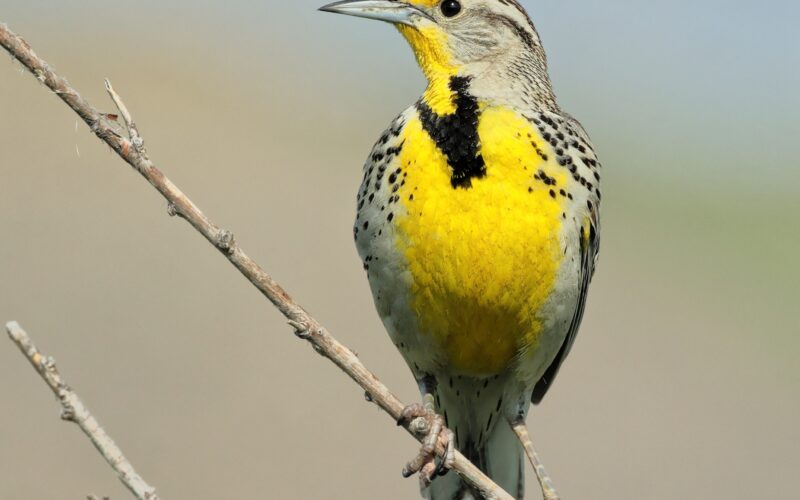
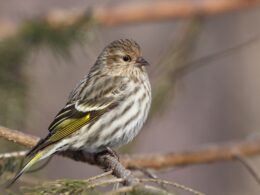
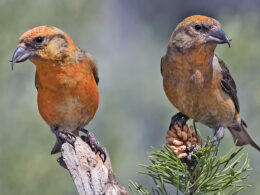
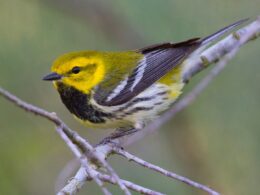
Hi Greg, thanks for this easy to follow guide. My husband gets to see all the birds at the feeder now that he's working from home so it's fun to be able to identify them.
I'm so glad this article was useful, Mary.
Working from home is fun–especially when there are little things out the window to distract you. Don't tell the boss!
Thanks for the list. I have three mesh feeders in the back (sunflower seed to other seeds) and one feeder with only peanuts. This attracts the blue jays and crows, the other feeders mostly sparrows and finches here in Manhattan. I have seen plenty of other species feeding, but sparrows and finches are the most common at my feeders.
You are welcome, Jerry!